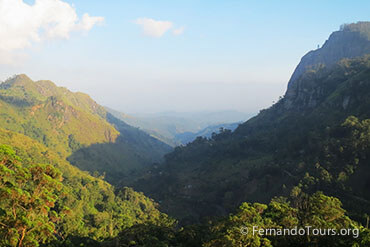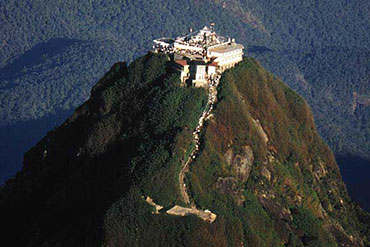
Wildlife & Nature
Horton Plains, a breathtaking plateau in central Sri Lanka, stands as a natural wonder and is a key attraction for nature enthusiasts and adventurers alike. As a UNESCO World Heritage Site, Horton Plains National Park offers a unique and diverse ecosystem, featuring rolling grasslands, dense cloud forests, and cascading waterfalls.
The star attraction within Horton Plains is World’s End, a dramatic escarpment that provides panoramic views of the surrounding landscapes. Hiking trails meander through the park, leading visitors to iconic landmarks such as Baker’s Falls, a picturesque waterfall surrounded by lush vegetation.
The park is renowned for its rich biodiversity, housing a variety of flora and fauna unique to the region. Endemic species, including the elusive sambar deer and purple-faced langur monkeys, roam freely in their natural habitat. Birdwatchers can delight in spotting vibrant bird species like the Sri Lankan whistling thrush and the yellow-eared bulbul.
Horton Plains’ cool and misty climate adds to its allure, creating an otherworldly atmosphere. The famous trek to World’s End, especially during the early morning, offers a surreal experience as the mist gradually lifts, revealing the stunning landscapes below.
“Horton Plains stands as a unique gem among Sri Lanka’s national parks, distinguished as the only one where visitors are permitted to explore on foot. This exceptional park invites you to wander freely amidst its breathtaking landscapes, making it a rare and immersive experience within the country’s natural reserves.”
Wear your clothes in layers as it can be very cold in the early morning hours and become very hot when the sun comes out.
As the roads are in a very bad condition, we have to hire a jeep or a van to get to the Horton Plains National Park.
Please note there is an entrance fee to Horton Plains.

Towns & Cities
Ella, nestled amidst the lush hills of Sri Lanka, is a charming town renowned for its breathtaking landscapes, cool climate, and laid-back atmosphere. Perched at an elevation of around 1,041 meters above sea level, Ella offers panoramic views of verdant tea plantations, mist-covered mountains, and cascading waterfalls.
The town is a haven for nature lovers and hikers, with a myriad of trekking trails leading to iconic sites. Little Adam’s Peak, a popular trekking destination, rewards adventurers with stunning vistas of Ella’s surroundings. The Ella Rock hike is another exhilarating experience, offering breathtaking views of the Ella Gap.
Ella is surrounded by lush tea estates, and a visit to the famous Nine Arch Bridge is a must. This architectural marvel is set against a backdrop of emerald-green tea plantations, creating a scene reminiscent of a postcard.
The tranquil atmosphere of Ella extends to its town center, where visitors can explore local markets, enjoy authentic Sri Lankan cuisine, and interact with the friendly locals. The vibrant blend of culture and nature makes Ella a perfect retreat for those seeking relaxation and adventure.
As the sun sets, the cool mountain air and the serene ambiance make Ella an enchanting destination. Whether you’re sipping on Ceylon tea in a hillside café or strolling through the picturesque landscapes, Ella captivates with its natural beauty and laid-back charm, inviting travelers to experience the essence of Sri Lanka’s hill country.

Adventure
Adam’s Peak, also known as Sri Pada, is a revered and iconic mountain located in central Sri Lanka. It is a site of religious significance for multiple faiths, attracting pilgrims and tourists alike. Here are key features of Adam’s Peak:
1. Religious Significance: Adam’s Peak holds religious importance for Buddhists, Hindus, Christians, and Muslims. Each religious community has its own beliefs about the footprint at the summit. Buddhists believe it is the footprint of Lord Buddha, Hindus attribute it to Lord Shiva, and Christians and Muslims associate it with Adam or the Prophet Adam.
2. The Sacred Footprint: At the summit, there is a rock formation that is believed to be the footprint of the respective deity. Pilgrims climb the mountain to pay homage to this sacred footprint and seek blessings.
3. Pilgrimage Season: The pilgrimage season to Adam’s Peak typically begins in December and continues until the Vesak festival in May. During this time, thousands of pilgrims and tourists make the ascent to witness the sunrise from the summit.
4. Climbing Routes: There are several routes to ascend Adam’s Peak, with the most popular being the traditional route from the town of Nallathanniya (or Dalhousie). The climb is a challenging but rewarding trek, consisting of a series of steps.
5. Steps and Staircases: The climb is facilitated by well-constructed steps and staircases along the route. The number of steps varies, with some estimates exceeding 5,000 steps. Pilgrims often climb at night, guided by the light of lanterns, to reach the summit in time for the sunrise.
6. Panoramic Views: The summit of Adam’s Peak offers breathtaking panoramic views of the surrounding landscapes, especially during sunrise. The sight of the shadow of the peak cast on the clouds, known as the “Sri Pada shadow,” is a unique and awe-inspiring phenomenon.
7. Tea Plantations: The lower slopes of Adam’s Peak are often surrounded by picturesque tea plantations, adding to the scenic beauty of the region. Visitors can explore the lush greenery and enjoy the tranquility of the tea estates.
8. Historical Ruins: Along the climbing route, there are remnants of ancient structures, including a stupa and a temple. These historical ruins add a cultural dimension to the pilgrimage.
Climbing Adam’s Peak is not only a physical journey but also a spiritual and cultural experience. It is a pilgrimage that transcends religious boundaries, symbolizing unity and shared reverence for the sacred site.


